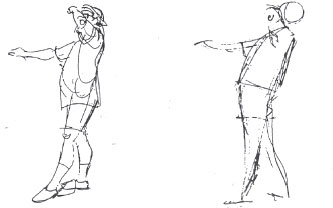In Unlimited Power by Anthony Robbins, a book on personal achievement, the author uses “acting like” as a tool to do what you want to do and to become who you want to become. Part of his premise is that physiognomy has a great deal to do with the way you feel and how you achieve. Physiognomy means the art of discovering temperament and character from outward appearance…. External aspect; hence, inner character as revealed outwardly. He teaches that even the attitude or stance one takes, signals the brain and the whole nervous system of the body, enabling it to carry out its “acting like” or pretended intentions. Even Charlie Brown understands this:.

I see this as an important tool in drawing, too. Most of the drawings that come short of the mark are the ones where the artist didn’t “act like” (mentally or physiognomically) the gesture of the model or something drawn from the imagination. To illustrate this, let me ask you to imagine yourself having to pound a big spike into a thick piece of hard wood. Your mental picture will certainly not be like the actions you would take to place a cup of hot tea into someone’s hands. No, you would picture yourself lifting the hammer high enough to get some power and speed behind the swing. You’d lean back, putting what you might consider the maximum distance that you could accurately swing the hammer and still hit the nail head. You’d turn your shoulder for extra power; you’d tighten the muscles of your stomach for additional support, and you might even squint your eyes and grit your teeth. Then you’d unleash all that gathered power in one great manly whack at the nail.
When you are drawing, such a mental picture would be transposed into graphite or ink onto paper. And it has to be a conscious, active, and assertive involvement. It’s not too complicated. We’re talking simple (but energized) things like a stretch or a squash, or a bend, or a twist; or a couple of angles working against each other. We’re talking perspective — things that are close appearing larger, things far away, smaller. We’re talking things coming at you or going away from you in space. We’re talking weight distribution and balance and tension, push and pull — all the things you would do naturally with your body if you were to carry out some action or gesture, things that you would have to rehearse mentally before you could do them, or draw them.
Drawing is total involvement. You can’t “stand off” and watch it being done — you have to “step into it” and do it yourself. I recently read a book called Lost in Translation by Eva Hoffman. That title suggests an explanation for many aborted attempts to draw a gesture. We may see the pose perhaps in a shallow sense (maybe we look but don’t really see it). Then when we try to draw it, the kinesthetic feeling having not reached the true sense of it, or the picture being weak in our minds, allows it to get lost in translation.
I have a few drawings here that I hope will graphically illustrate the point. In the first drawing the artist has the body at ease as she peers down into her blouse opening, and as they say of some animation, “it moves but it doesn’t animate.” In my suggestion sketch I have her straighten up slightly, forcing her neck back, making it

easier to look down, and I thrust the left elbow out for a cleaner pull on the collar. Looking from one drawing to the other you can see it become a stronger look.

In the next pose, the model was bending at the waist. The long, curved, sweeping line from heel to shoulder cancels out any hope for a clean bend at the waist. Also with the definite angle of the upper torso, it gives the right arm a better stretch. This is an example of opposition — one part going in one direction and one part going in another. It adds power and spark to a gesture.
In this next drawing the artist has a lot of curved lines, which when used in such profusion, have a tendency to cancel out anything of a definite nature. The model was standing alertly looking at something. In this attitude one thrusts out the chest and stomach, stretching the whole body. It makes a clean “springboard” for the look to travel to the object of its interest, unheeded by a lot of unnecessary clutter. Curved lines can be used at the rear of the figure to help identify the shapes.
Here is a similar problem where the stretch side of the body was drawn with mostly angles and curves. The solution was to introduce a more definite “stretch,” which in turn intensified the pose.

In this last illustration the model was bending back at the waist drinking a glass of water, his right hand resting on the water dispenser. The act of drinking water (or whatever action) should be imagined and felt in your body before starting to draw. The thrusts and stretches and bodily tensions will then be apparent, and easier to transpose onto paper.

